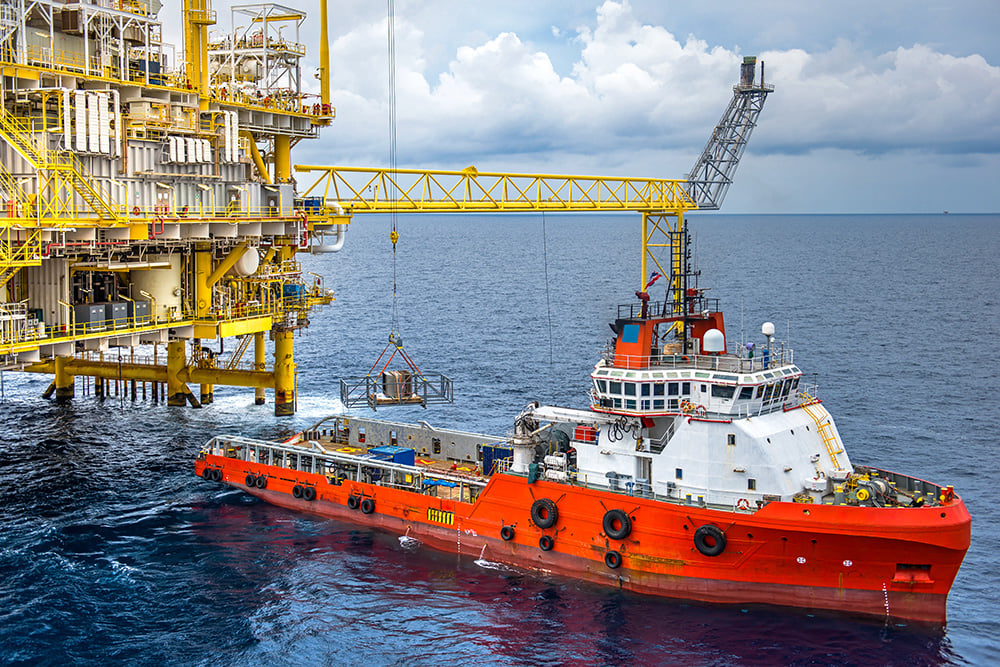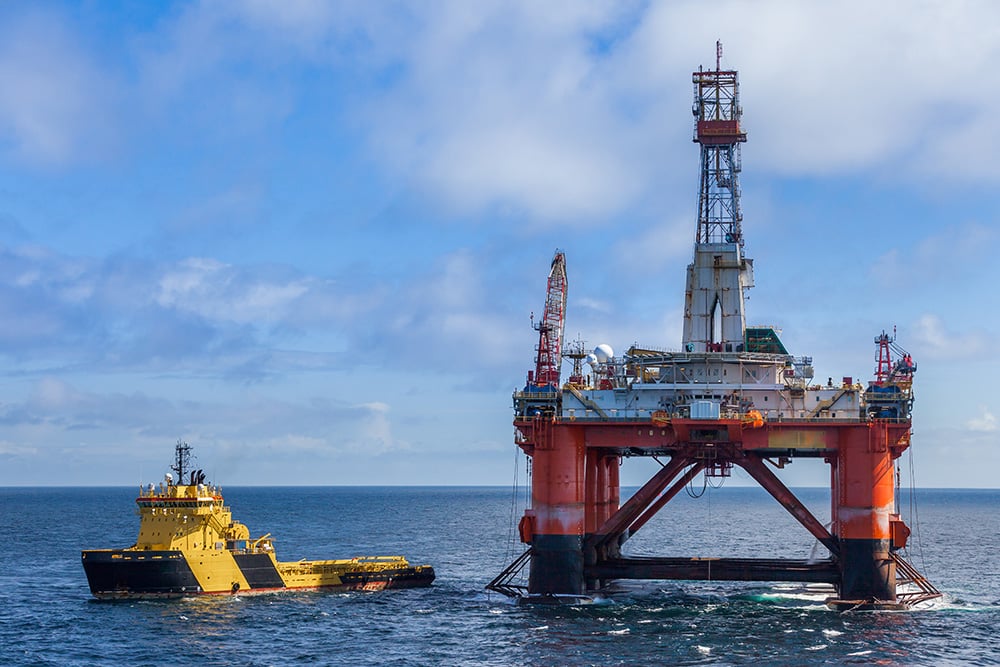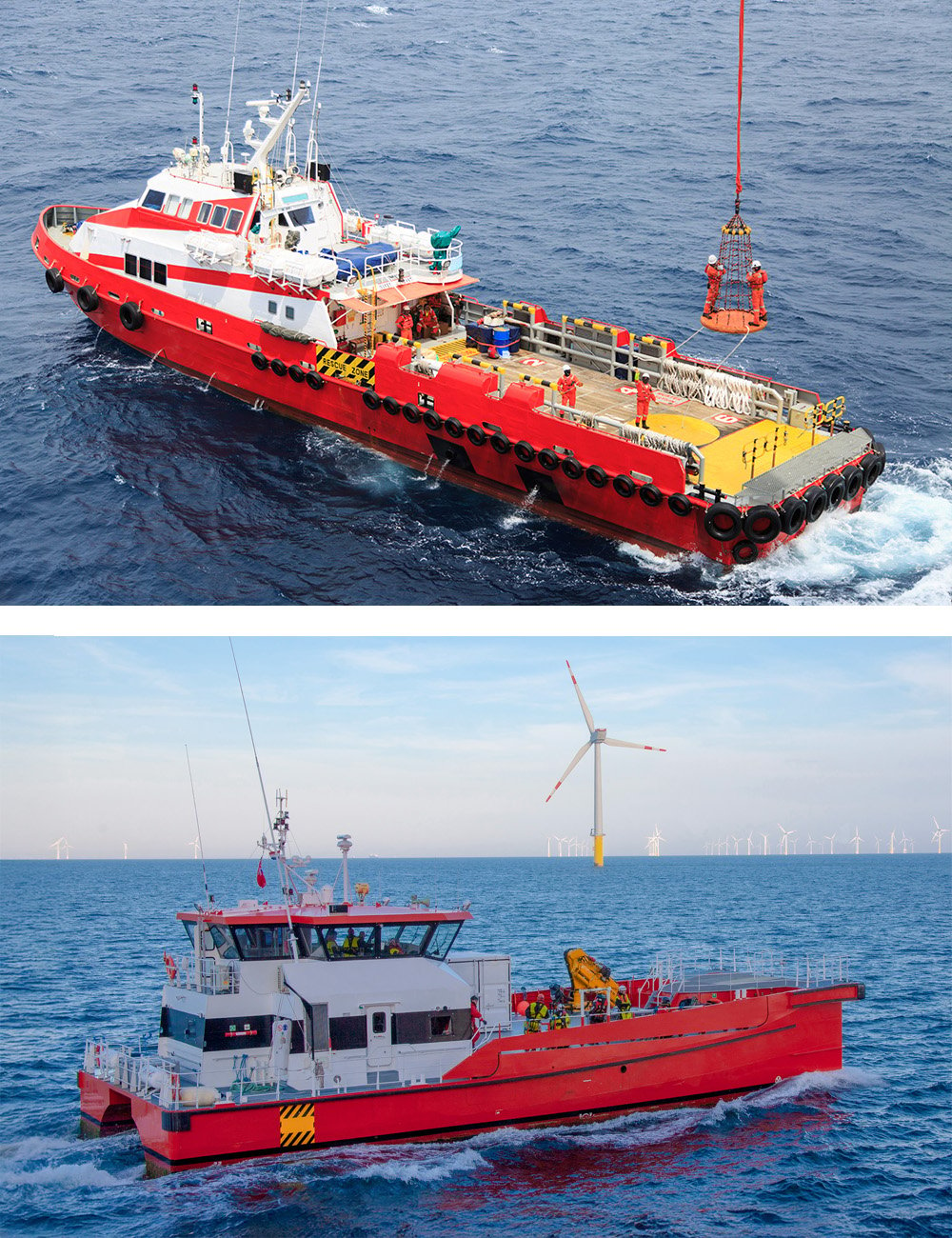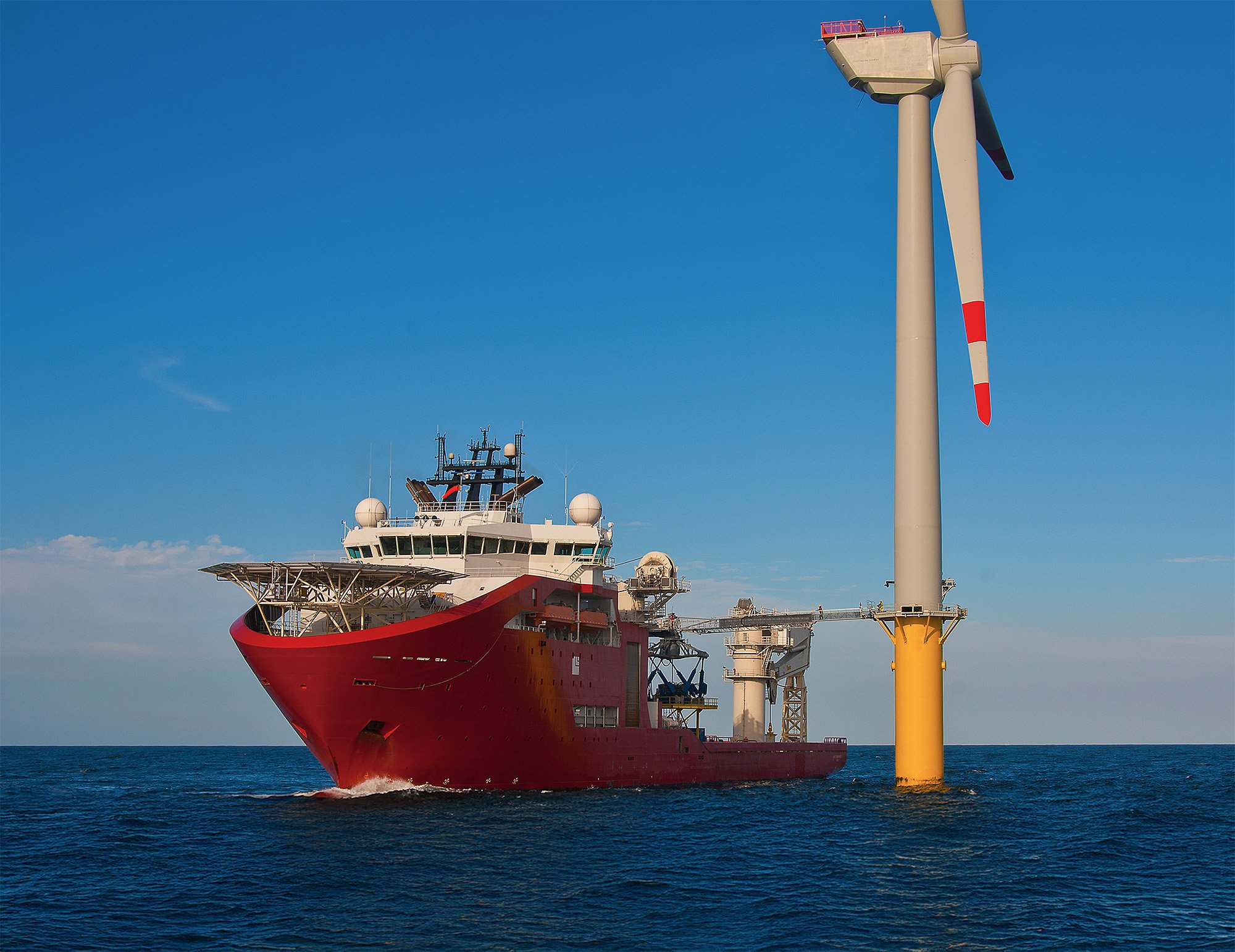A Guide to Offshore
Support Vessels
Overview of vessel categories
currently in operation worldwide
Free Download

This guide offers a comprehensive resource for industry professionals on offshore support vessels. It breaks down what each vessel does, why it matters, and how it fits into offshore operations, creating a useful reference for anyone needing a quick overview or deeper understanding.
Section 1: Overview
Offshore support vessels (OSVs) are specialised ships designed to service and supply the offshore energies sector. These assets are self-propelled and are often designed to include elements such as cranes, open work decks and hydraulic & power systems. OSV services can include supplying cargo and goods, transferring personnel, survey operations, construction and decommissioning, towage, anchor handling operations, safety & standby services, inspection, maintenance and repair services etc. Cargoes also vary widely but may include fuel, water, and chemicals used during construction. Additionally, some OSVs are specially designed for emergency and rescue services. They are prepared for evacuation missions, and their equipment can include, for example, fire or oil spill control systems.
Overall, the term OSV represents an umbrella category encompassing a variety of vessel types, e.g. Platform Supply Vessels, Construction Support Vessels etc. Indeed, OSVs are versatile, and are often designed for various tasks and are considered multi-purpose assets.
Originating in the mid-20th century with the rise of offshore drilling, OSVs have evolved to meet growing technological and environmental demands. Modern OSVs are built to endure harsh marine environments, featuring state-of-the-art navigation systems, dynamic positioning capabilities, and robust safety mechanisms.
Section 2: Operational Support Vessels
2.1: Platform Supply Vessels (PSV)
Platform Supply Vessels (PSVs) are essential support ships within the OSV category, designed to provide logistical services for the offshore energies sector. As a vessel type, these assets have two main roles. Primarily, they transport vital supplies, equipment, and crew to and from offshore platforms, facilitating efficient construction, operation, and maintenance operations. Cargoes are either transported on the ship’s main deck or inside its tanks below deck. As well as this, they also provide operational support through carrying firefighting and oil spill response equipment, ensuring rapid response to incidents when necessary.
PSVs can face significant challenges including severe weather and the need for precise navigation. To overcome these, they are often equipped with dynamic positioning systems, advanced GPS, weather monitoring systems, and specialised hull designs. These features enable safe, efficient operations even under harsh offshore conditions, making PSVs indispensable in modern maritime logistics.


Section 2: Operational Support Vessels
2.2: Anchor Handling Tug Supply (AHTS) Vessels
Anchor Handling Tug Supply (AHTS) vessels are purpose-built to manage the challenges of towing and anchoring large offshore structures, such as drilling rigs and floating production systems. They are also capable of carrying, handling, and placing anchors and chains of oil and gas infrastructure.
Central to their design is high bollard pull, achieved through powerful engines, large propellers, and reinforced hulls, enabling them to handle heavy loads in extreme conditions. These assets are also designed with dedicated deck space for anchor chains, towing wires, and equipment, while a stern roller ensures smooth deployment and retrieval of wires & anchors over the vessel’s stern. Stability is also paramount to the design of AHTS.
Beyond their primary roles, AHTS vessels can double as supply carriers, delivering cargo, fuel, and equipment to offshore installations—mirroring the versatility of PSVs. Their value extends to emergency response, as they can be outfitted with firefighting systems and emergency towing gear.
Section 2: Operational Support Vessels
2.3: Emergency Response & Rescue Vessels (ERRV)
Emergency Response & Rescue Vessels (ERRVs) are specialised ships designed for supervising of surroundings and to act immediately in emergencies like oil spills or fires. They respond to incidents such as collisions and evacuations with advanced firefighting systems, medical facilities, and rescue equipment. Other operations include standby, guard, acting as a rescuer and place of safety in emergencies, supervising safety zones and informing approaching vessels, and if necessary, working as a reserve radio station and act as an on-scene coordinator. Sub types of ERRV include Safety Standby Vessels, Emergency Towage Vessels, Oil Spill Recovery or Response Vessels and Offshore Patrol Vessels.
These vessels can be designed with rescue boats, dynamic positioning, and high-speed manoeuvrability to ensure effective response. Many ERRVs carry both daughter craft and fast rescue craft. Some ERRVs can also be fitted with mechanical recovery systems. Some ERRVs can also be fitted with mechanical recovery systems, for example crane-operated rescue nets that retrieve survivors directly from the water.


Section 2: Operational Support Vessels
2.4: Crew Transfer Vessels (CTV)
Crew transfer vessels (CTVs) are robust ships designed to safely transport personnel between offshore installations and ports under various conditions. Designed with high-speed capabilities and enhanced stability, CTVs facilitate crew transfers, addressing needs such as routine changes, medical emergencies, repairs, or inspections.
Offshore wind is supporting utilisation of these vessels as they are used to transport technicians and other personnel out to sites daily. Within this sector, two primary transfer methods are commonly used. The “bump and jump” method involves positioning the vessel against turbine access ladders, allowing crew to step over while a designated safety zone mitigates movement risks. Alternatively, the “Walk to Work” method works using a heave compensating bridging method that attaches to the ladder and keeps the bridge stationary.
CTVs can be used to take small amounts of cargo out to sites, such as components and equipment for installation and servicing of offshore infrastructure.
Section 3: Specialised Support Vessels
3.1: Heavy Construction Support Vessels (Heavy CSV)
Heavy Construction Support Vessels (Heavy CSV) assist in large-scale construction and heavy lifting operations offshore. These vessels are designed with robust decks, heavy-duty cranes, and dynamic positioning systems that allow them to handle significant loads during installation, decommissioning, or repair projects. To be considered a heavy CSV, heavy CSVs operate with cranes between 200 and 400 tonnes.
These vessels typically support both surface and subsea installation work. Workscopes can include a range of construction-related tasks such as trenching, ploughing, and the installation of subsea infrastructure & structural components for fixed or floating offshore facilities. Offshore construction campaigns often require these vessels to remain on site for extended periods to execute complex, multi-phase operations.
.jpg?width=1000&height=1300&name=Fortitude%20%26%20Saipem%207000%20(CSV).jpg)

Section 3: Specialised Support Vessels
3.2: Light Construction Support Vessels (Light CSV)
Light Construction Support Vessels (Light CSV) complement their heavier counterparts by addressing the needs of less demanding construction and maintenance tasks. Typically, with a lesser crane capacity (>200 tonnes), these assets are utilised for tasks that require moderate lifting, transportation, and on-site assembly support. These vessels can also be utilised for IRM work, or inspection, repair, and maintenance.
Light CSVs evolved from multipurpose Platform Supply Vessels (PSVs) and are often deployed in supporting or secondary role. They typically feature cranes capable of handling light construction, and are often configurable for a wide range of potential activities.
Section 3: Specialised Support Vessels
3.3: Diving Support Vessels (DSV)
Diving Support Vessels (DSV) are specialised ships that provide a stable platform for diving operations conducted in offshore environments. DSVs can range from converted vessels fitted with air diving spreads to purpose-built vessels outfitted with complex saturation diving systems.
DSVs are critical in facilitating underwater inspections, repair and installation tasks that require direct human intervention. Diving support vessels can also perform other tasks alongside their main purpose, like remotely operated vehicle operations.
DSVs must maintain precise positioning and reliable station-keeping capabilities to ensure diver safety and operational efficiency, even in rough seas. To meet these demands, DSVs are often required to comply with Dynamic Positioning (DP) Class 2 standards as a minimum. This classification mandates redundant technical systems (e.g., duplicate thrusters, power supplies, and control units) to prevent single-point failures. Additionally, DP Class 2 requires an independent backup joystick system, enabling manual override in emergencies. These safeguards allow DSVs to hold their position steadily, creating a stable, controlled workspace for divers during complex subsea tasks. DSVs will also feature a moonpool; this is where divers, ROVs, and equipment are lowered into the water.
.jpg?width=1000&height=1300&name=Boka%20Polaris%20%26%20Seven%20Atlantic%20(DSVs).jpg)

Section 4: Offshore Installation Vessels
4.1: Pipe Lay Vessels
The primary role of a Pipe Lay Vessel is to install subsea pipelines, flexible and rigid, along a preplanned seabed route.
There are several pipe laying methods. In the reel-lay method, pipe is welded onshore, spooled onto a large reel, and unspooled at sea to lay on the seabed.
In the S-lay method, individual pipe sections are welded onboard and guided off the vessel in an “S” shape using a stinger; this method is fast and works well in various depths.
The J-lay method also involves welding pipe onboard, but the pipe is lowered nearly vertically, making it ideal for deepwaters.
The flex-lay method is used for flexible pipelines, which are stored on reels or carousels and laid continuously on the seabed.
During pipe laying, the vessel must maintain precise positioning while slowly advancing—a critical factor for successful installation. Tension in the deployed pipeline must be carefully managed to avoid stress, buckling, or misalignment.
Section 4: Offshore Installation Vessels
4.2: Cable Lay Vessels
A Cable Lay Vessel (CLV) is a vessel used to lay subsea cables. These cables can serve various purposes, including telecommunications, electrical power transmission, and control signals between offshore installations and onshore facilities.
Cables are typically stored in large carousels onboard the vessel. Modern CLVs often have the capacity to carry and install multiple cable lines during a single offshore campaign, though cables are usually laid one at a time.
Some CLVs are designed for cable repair rather than installation. These assets are typically smaller and more manoeuvrable than their counterparts, although combination assets also exist.
Nevertheless, all CSVs require a high degree of manoeuvrability and stability to facilitate the precise and correct laying of cables on the seabed. This is achieved via utilisation of dynamic tracking and dynamic positioning systems which pinpoint the exact position of both the cable layer, and the point at which the cables should be laid. Cable vessels are also equipped with damage control systems which can be deployed in the event of cables being damaged.
_low%20res2_(steph%20image).jpg?width=1000&height=680&name=Seven%20Seas%20(cable%20-%20flexlay)_low%20res2_(steph%20image).jpg)

Section 4: Offshore Installation Vessels
4.3: Conventional Heavy Lift Vessels
Conventional heavy lift vessels are equipped with substantial lifting capacities, ranging from hundreds to several thousand tonnes (400 tonnes+). These vessels perform complex offshore construction tasks, such as the transportation and installation of jackets and foundations for offshore wind turbines and oil and gas platforms. They are also frequently used for the decommissioning of aging offshore infrastructure.
Unlike semi-submersible vessels that rely on buoyancy and ballasting to float structures on and off, conventional heavy lift vessels typically feature one or more large cranes capable of precision lifts in dynamic offshore environments.
These vessels can utilise motion-compensated technology, advanced dynamic positioning and specialised cargo barge transfer systems.
Section 4: Offshore Installation Vessels
4.4: Heavy Lift Semi-Submersible Vessels
Semi-submersible heavy lift vessels are specialised ships designed to transport massive offshore structures (e.g. oil production platforms, FPSOs) by leveraging a unique submersible well deck.
This deck is flooded via ballast tanks to submerge below the waterline, allowing cargo to be floated on or off. Once loaded, the tanks are pumped out to raise the deck and secure the cargo. Precision ballasting systems enable uneven tank drainage to stabilise asymmetrical loads during transit.
The design of Heavy lift Semi-Submersible Vessels is considerably different from that of conventional ships. For instance, the superstructures present on the deck are located at the extreme fore and stern. The bridge, living quarters, offices and other areas used by the crew are located at the fore which provides personnel in the bridge with a clear view of the surrounding area for manoeuvres and loading operations. The machinery used for the operations of the ship is located at the other extreme end. For instance, some types of semi-submersibles have their ballast pumps or marine engines located here.


Section 4: Offshore Installation Vessels
4.5: Wind Turbine Installation Vessels (WTIVs)
Wind turbine installation vessels (WTIVs) are designed for the installation and construction of wind turbines offshore. These vessels typically use a jack-up design in which a set of legs are lowered to the sea floor to raise the vessel's deck above the water's surface. In deeper water, where the jack-up legs cannot operate, the vessel will use a DP system to maintain its position.
Equipped with ultra-heavy-lift cranes, WTIVs hoist turbine components—blades, nacelles, and tower sections—onto pre-installed foundations.
As offshore wind farms expand into deeper waters and deploy larger turbines, next-gen WTIVs are evolving with enhanced lifting capacities – often reported as heavy-duty WTIVs. Further developments include advanced dynamic positioning, dual-fuel main engine and hybrid battery systems. As these assets are working in the renewable energy sector, the environmental footprint is often key consideration, with high efficiency and low carbon emissions essential in design.
Section 5: Accommodation & Workforce Support
5.1: Accommodation Units
Accommodation units are specialised facilities designed to house and support crews working on offshore energies projects.
These self-contained structures prioritise safety, comfort, and operational efficiency, enabling personnel to live and work onsite for extended periods in harsh marine environments. They are often situated in direct proximity to the construction or project site in order to minimise transit time.
An offshore accommodation vessel frequently serves as a construction office or control centre at sea with various communication and conference rooms. Along with a large number of cabins, many floating hotels also provide sufficient storage for offshore spare parts and workshops for various types of repair work.
Modern accommodation units feature advanced amenities such as climate-controlled cabins, dining halls, gyms, medical facilities, and recreational areas, alongside critical safety systems like firefighting equipment, emergency exits, and lifeboats.
Applications range from providing temporary housing during platform installations or repairs to serving as maintenance hubs for offshore wind farms or bases for decommissioning projects.


Section 5: Accommodation & Workforce Support
5.2: Semi-Submersible
A semi-submersible accommodation vessel, often referred to as a floatel, is a specialised offshore support unit designed to house and support personnel working on remote oil, gas, or renewable energy installations. Unlike jack-ups, these vessels use submerged pontoons and vertical columns for stability, allowing them to operate in harsh environments like the North Sea.
Section 5: Accommodation & Workforce Support
5.3: Jack-Up
A jack-up accommodation vessel is a self-elevating offshore platform used to house and support personnel working on energy projects at sea, particularly in shallow to moderate water depths. Unlike floating vessels, it stands on legs jacked down to the seabed, providing a stable, motion-free platform ideal for long-term offshore stays.


Section 5: Accommodation & Workforce Support
5.4: Barge
An accommodation barge is a non-self-propelled vessel designed to provide temporary housing and support facilities for personnel working in offshore or coastal environments. It is only intended to accommodate people when securely moored in place, with only essential crew are onboard during transit. They are cost-effective, especially in remote or shallow-water locations, and can be towed to different sites as needed.
Section 5: Accommodation & Workforce Support
5.5: Service Operation Vessels (SOV)
Service Operation Vessels (SOVs) are advanced maritime platforms designed to support the operation and maintenance of offshore wind farms, acting as mobile bases for technicians and equipment. Equipped with dynamic positioning (DP) systems, SOVs maintain precise positions near turbines, even in rough seas, enabling safe and efficient crew transfers via motion-compensated gangways or daughter craft. These vessels feature onboard workshops, spare parts storage, and crane systems to facilitate repairs, blade inspections, and component replacements. Accommodation for up to 100+ technicians includes cabins, dining areas, and recreational facilities, allowing extended offshore stays. SOVs can also integrate hybrid or LNG-powered propulsion systems to reduce emissions and operational costs, aligning with the renewable energy sector’s sustainability goals. Advanced data centres onboard enable real-time monitoring of turbine performance, streamlining preventive maintenance. By minimizing reliance on helicopters and port returns, SOVs enhance operational uptime and safety, particularly in remote or deepwater wind farms. Their versatility extends to supporting subsea inspections and cable repairs, making them indispensable for maximizing the lifespan and efficiency of offshore renewable energy infrastructure.


Section 6: Liftboats
Liftboat Overview
Liftboats are self-propelled, self-elevating vessels with open deck areas, cranes, and living accommodations to support offshore petroleum or wind development activities. Upon arrival at a designated work site, a liftboat lowers its legs until they make contact with the seabed. Once a liftboat reaches the optimal elevation, it ceases jacking operations, and the crew can commence work.
Liftboats share the same critical systems as any ship but with the addition of cranes and jacking systems. Propulsion and maneuvering systems are of particular importance on liftboats due to the close proximity required during offshore platform approaches.
Jacking systems are made by various manufacturers and models but can generally be separated into two categories: pin & hole (P&H) and rack & pinion (R&P). R&P is more commonly found on liftboats and is either electric or hydraulically driven. One reason that R&P is more common is due to the higher “leg speed” these systems provide relative to a P&H system. Leg speed is a measure of how fast a liftboat’s legs can descend to the seabed. The faster a vessel’s leg speed, the less time it is freely floating next to a platform and exposed to the risks of a collision.
Liftboats servicing the petroleum industry generally have cranes of 500 tons or less. In contrast, the offshore wind industry utilizes liftboats with cranes of 1,500 tons for the installation of foundations, towers, and turbines.
.jpg?width=1500&height=900&name=AdobeStock_230795226_Offshore%20support%20vessels%20(OSV).jpg)


_low%20res_(steph%20image).jpg?width=1500&height=900&name=Seven%20Seas%20(cable%20-%20flexlay)_low%20res_(steph%20image).jpg)

